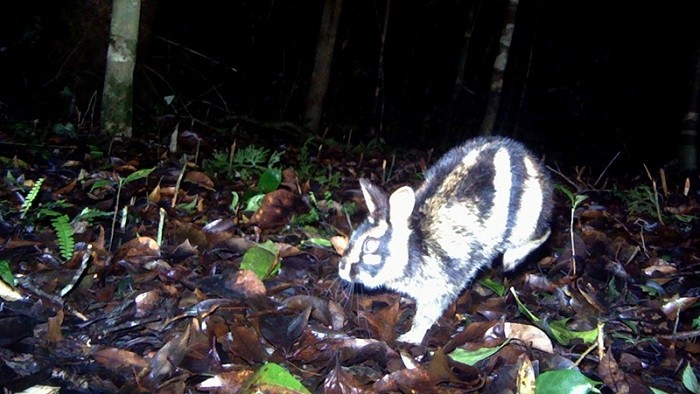According to the IUCN Red List, this species is classified as Endangered.
Dr. Le Van Huong, Director of the Bidoup-Nui Ba National Park, said this special animal was discovered in September 2020, by scientists from the national park’s Tropical Forest Research Centre in collaboration with the Southern Institute of Ecology (SIE), Leibniz Institute for Zoo and Wildlife Research (Leibniz-IZW) and Global Wildlife Conservation (GWC).
Previously, the striped rabbit, an ancient mammal from the Truong Son (Annamite) range, was thought to be distributed only in north and central Truong Son. This new sighting is more than 400 km south of the previously known range. The discovery of a new population is very important for the conservation of this globally threatened species.
 |
Former range and new discovery of the striped rabbit in the Bidoup-Nui Ba National Park. (Photo: Bidoup-Nui Ba National Park)
“We were really surprised to see the Annamite striped rabbit in the data obtained from the camera trap. No one would have expected this species to appear so far away from its known range. This shows that we still know very little about the forests along the Annamite Mountains,” said Dr. Andreas Wilting, researcher from Leibniz-IZW.
Currently, scientists are planning a deeper survey to assess the population status of the species and find out how the newly discovered population in Bidoup-Nui Ba National Park is genetically different compared with the populations in northern and central Truong Son.
Master Le Duy, a researcher from the SIE and one of the main members of the survey team, said: “We are trying to collect as much data about the newly discovered population as possible. In-depth genetic studies and surveys on the population status of the species in the near future will provide very important scientific information assisting the planning and implementation of conservation activities to preserve this endemic species.”
The rabbit is only one of the rare and endangered species that scientists discovered in the Bidoup-Nui Ba National Park. Surveys from September 2020 to October 2021 also recorded species such as muntjacs, civets and sun bears, showing that Bidoup-Nui Ba National Park is one a protected area with one of the highest levels of biodiversity in Vietnam.
 |
Photos of the striped rabbits found in the Bidoup-Nui Ba National Park as published in the scientific journal “Mammalia”. (Photo: Bidoup-Nui Ba National Park).
According to the director of the national park, the publishing team will continue to work with its partners to further study the population trends, density and ecological factors affecting the existence of the species.
“What we worry about is the risk this population decline will lead to the local extinction of the only known population of these striped rabbits in the southern Truong Son. We are eager to take concrete action to protect this endemic species, as part of our efforts to conserve the biodiversity that makes Bidoup-Nui Ba National Park so special," Dr. Huong said.
















